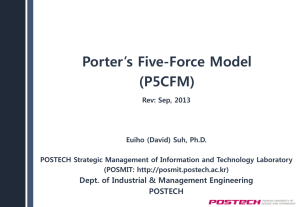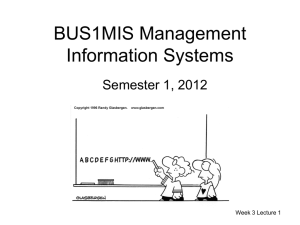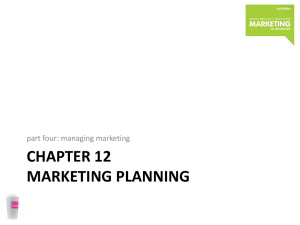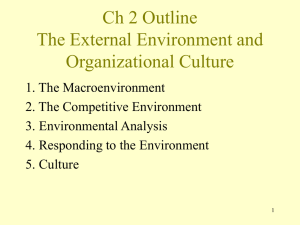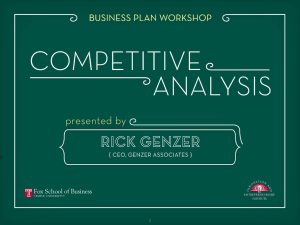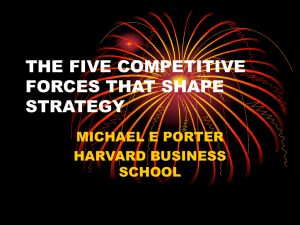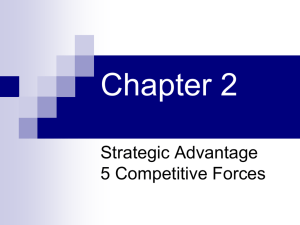Chapter 2
advertisement
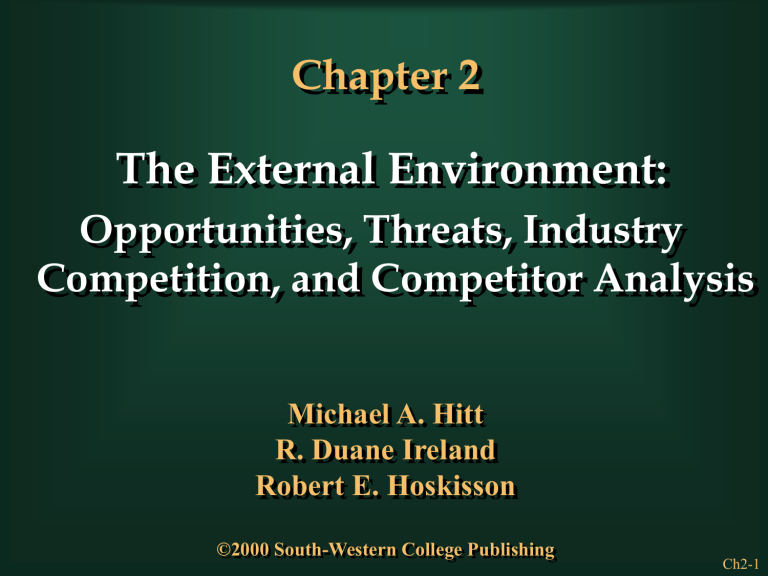
Chapter 2 The External Environment: Opportunities, Threats, Industry Competition, and Competitor Analysis Michael A. Hitt R. Duane Ireland Robert E. Hoskisson ©2000 South-Western College Publishing Ch2-1 Components of the General Environment Economic Demographic Sociocultural Industry Environment Competitive Environment Political/ Legal Global Technological Ch2-2 SWOT Analysis • • • • Strengths Weaknesses Opportunities Threats Ch2-3 The purpose of SWOT Analysis • It is an easy-to-use tool for developing an overview of a company’s strategic situation – It forms a basis for matching your company’s strategy to its situation Ch2-4 SWOT is the starting point • It provides an overview of the strategic situation. • It provides the “raw material” to do more extensive internal and external analysis. Ch2-5 Opportunities • An OPPORTUNITY is a chance for firm growth or progress due to a favorable juncture of circumstances in the business environment. • Possible Opportunities: – Emerging customer needs – Quality Improvements – Expanding global markets – Vertical Integration Ch2-6 Threats • A THREAT is a factor in your company’s external environment that poses a danger to its well-being. • Possible Threats: – New entry by competitors – Changing demographics/shifting demand – Emergence of cheaper technologies – Regulatory requirements Ch2-7 Opportunities and Threats form a basis for EXTERNAL analysis • By examining opportunities, you can discover untapped markets, and new products or technologies, or identify potential avenues for diversification. • By examining threats, you can identify unfavorable market shifts or changes in technology, and create a defensive posture aimed at preserving your competitive position. Ch2-8 The purpose of Five-Forces Analysis • The five forces are environmental forces that impact on a company’s ability to compete in a given market. • The purpose of five-forces analysis is to diagnose the principal competitive pressures in a market and assess how strong and important each one is. Ch2-9 Porter’s Five Forces Model of Competition Threat of Threat of New New Entrants Entrants Ch2-10 Threat of New Entrants Economies of Scale Barriers to Entry Product Differentiation Capital Requirements Switching Costs Access to Distribution Channels Cost Disadvantages Independent of Scale Government Policy Expected Retaliation Ch2-11 Porter’s Five Forces Model of Competition Threat of Threat of New New Entrants Entrants Bargaining Power of Suppliers Ch2-12 Bargaining Power of Suppliers Suppliers are likely to be powerful if: Suppliers exert power in the industry by: * Threatening to raise prices or to reduce quality Powerful suppliers can squeeze industry profitability if firms are unable to recover cost increases Supplier industry is dominated by a few firms Suppliers’ products have few substitutes Buyer is not an important customer to supplier Suppliers’ product is an important input to buyers’ product Suppliers’ products are differentiated Suppliers’ products have high switching costs Supplier poses credible threat of forward integration Ch2-13 Porter’s Five Forces Model of Competition Threat of Threat of New New Entrants Entrants Bargaining Power of Suppliers Bargaining Power of Buyers Ch2-14 Bargaining Power of Buyers Buyer groups are likely to be powerful if: Buyers are concentrated or purchases are large relative to seller’s sales Purchase accounts for a significant fraction of supplier’s sales Products are undifferentiated Buyers face few switching costs Buyers’ industry earns low profits Buyers compete with the supplying industry by: * Bargaining down prices * Forcing higher quality * Playing firms off of each other Buyer presents a credible threat of backward integration Product unimportant to quality Buyer has full information Ch2-15 Porter’s Five Forces Model of Competition Threat of Threat of New New Entrants Entrants Bargaining Power of Suppliers Bargaining Power of Buyers Threat of Substitute Products Ch2-16 Threat of Substitute Products Keys to evaluate substitute products: Products with similar function limit the prices firms can charge Products with improving price/performance tradeoffs relative to present industry products Example: Electronic security systems in place of security guards Fax machines in place of overnight mail delivery Ch2-17 Porter’s Five Forces Model of Competition Threat of Threat of New New Entrants Entrants Bargaining Power of Suppliers Rivalry Among Competing Firms in Industry Bargaining Power of Buyers Threat of Substitute Products Ch2-18 Rivalry Among Existing Competitors Intense rivalry often plays out in the following ways: Jockeying for strategic position Using price competition Staging advertising battles Increasing consumer warranties or service Making new product introductions Occurs when a firm is pressured or sees an opportunity Price competition often leaves the entire industry worse off Advertising battles may increase total industry demand, but may be costly to smaller competitors Ch2-19 Rivalry Among Existing Competitors Cutthroat competition is more likely to occur when: Numerous or equally balanced competitors Slow growth industry High fixed costs High storage costs Lack of differentiation or switching costs Capacity added in large increments Diverse competitors High strategic stakes High exit barriers Ch2-20 The Five Forces are Unique to Your Industry • Five-Forces Analysis is a framework for analyzing a particular industry. – Yet, the five forces affect all the other businesses in that industry. Ch2-21 Competitor Analysis The follow-up to Industry Analysis is effective analysis of a firm’s Competitors Industry Environment Competitive Environment Ch2-22 Competitor Analysis Assumptions What assumptions do our competitors hold about the future of industry and themselves? Current Strategy Does our current strategy support changes in the competitive environment? Future Objectives How do our goals compare to our competitors’ goals? Response What will our competitors do in the future? Where do we have a competitive advantage? How will this change our relationship with our competition? Capabilities How do our capabilities compare to our competitors? Ch2-23 Competitor Analysis Future Objectives What Drives the competitor? How do our goals compare to our competitors’ goals? Where will emphasis be placed in the future? What is the attitude toward risk? Ch2-24 Competitor Analysis Future Objectives How do our goals compare to our competitors’ goals? Where Current will emphasis be Strategy placed inHow the future? are we currently What is the attitude competing? toward risk? Does this strategy support changes in the competitive structure? What is the competitor doing? What can the competitor do? Ch2-25 Competitor Analysis Future Objectives What does the competitor believe about itself and the industry? How do our goals compare to our competitors’ goals? Where Current will emphasis be Strategy placed in the future? How are we currently What is the attitude competing? Assumptions toward risk? Does thisDo strategy we assume the future support changes in the will be volatile? competition structure? What assumptions do our competitors hold about the industry and themselves? Are we assuming stable competitive conditions? Ch2-26 Competitor Analysis Future Objectives What are the competitor’s capabilities? How do our goals compare to our competitors’ goals? Where Current will emphasis be Strategy placed in the future? How are we currently What is the attitude competing? Assumptions toward risk? Does this Dostrategy we assume the future supportwill changes in the be volatile? competition Whatstructure? assumptions do our competitors hold about the Capabilities industry and themselves? What are my competitors’ Are we operating under strengths and weaknesses? a status quo? How do our capabilities compare to our competitors? Ch2-27 Competitor Analysis Response Future Objectives How do our goals compare to our competitors’ goals? Where Current will emphasis be Strategy placed in the future? How are we currently What is the attitude competing? Assumptions toward risk? Does this Dostrategy we assume the future supportwill changes in the be volatile? competition Whatstructure? assumptions do our Capabilities competitors hold about the industry and themselves? What are my competitors’ Are we operating strengths under and weaknesses? a status quo? How do our capabilities compare to our competitors? What will our competitors do in the future? Where do we have a competitive advantage? How will this change our relationship with our competition? Ch2-28
